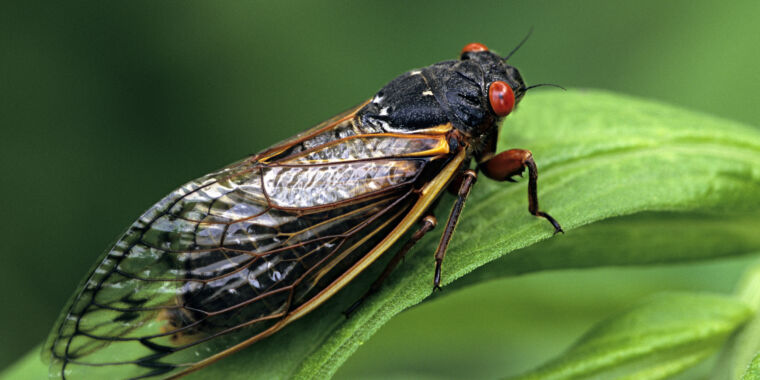Impending Cicada Emergence in Illinois
Illinois residents are gearing up for an extraordinary event as an unprecedented number of cicadas prepare to emerge, mate, and ultimately perish in the vicinity. A convergence of two broods of periodical cicadas, known as Brood XIX and Brood XIII operating on 13-year and 17-year cycles respectively, is on the horizon in central Illinois this upcoming summer. This occurrence will mark the first such event in over two hundred years. While humans perceive these insects as a transitory spectacle and a deafening annoyance before their departure, they serve as a rare source of sustenance for numerous other Midwestern creatures, flora, and microorganisms, bringing new vitality to aging forests.
Underground Development of Periodical Cicadas
Spanning from Nebraska to New York, a total of 15 subterranean broods of cicadas partake in an inconspicuous existence, as they quietly feed on the watery sap of tree roots. Following either a 13-year or 17-year incubation period, legions of adult cicadas measuring around an inch each resurface simultaneously in unison, emerging from below for a month-long reproductive celebration in the summer. Upon completing the mating process, they deposit eggs in the trees of forests and meet their demise, leaving their offspring to descend to the forest floor and perpetuate the cycle anew. Given their limited flight range from their birthplaces, each brood occupies a distinct portion of the United States, creating a picturesque mosaic across the landscape, as noted by Chris Simon, a distinguished research scientist specializing in ecology and evolutionary biology at the University of Connecticut.
Rare Coinciding Emergence
While a single brood typically surfaces each year (separate from the smaller periodical cicadas that appear independently every summer), it is not uncommon for two broods to emerge simultaneously. Concurrently, the coexistence of multiple broods in a single location also occurs occasionally. However, the imminent simultaneous emergence of Brood XIX and Brood XIII, juxtaposed adjacently, is an extraordinary event, according to John Lill, an insect ecologist associated with George Washington University. The state of Illinois is primed to serve as the epicenter of this phenomenon, engulfed by a wave of cicadas from its northern extremity to the southern reaches. The last instance where these two broods surfaced simultaneously transpired during the presidency of Thomas Jefferson, preceding the establishment of Chicago as a city.
Cicada Arrival: An Ecological Marvel
With entomologists worldwide eagerly anticipating the forthcoming arrival of the cicadas in May, excitement is palpable. Describing themselves as “cicada groupies,” the researchers are enthusiastic about the upcoming once-in-a-generation spectacle, proclaimed to surpass the allure of the total solar eclipse experienced in April. Recollecting the emergence of Brood X in 2004, John Lill reminisces about the awe-inspiring sight that greeted him late at night. Initially misconceived as rainwater cascading down the street, he soon realized that it was a multitude of cicadas traversing the pavement.
Cicadas and their Ecological Impact
For devoted enthusiasts like author and entomologist Greg Kritsky, witnessing Brood XIII emerge on a few occasions is a familiar sight. Conversely, for most predators, encountering a brood emergence as such occurs once in a lifetime and is a delightful surprise. Describing the event as a “food bonanza,” Kritsky analogizes the experience to stumbling upon a world teeming with airborne Hershey’s Kisses.
The cicadas, being exceedingly docile, protein-rich, and likened to premium shrimp in flavor, become easy and delectable prey. Classified as “sitting ducks” by Lill, these creatures refrain from biting, stinging, or inflicting harm, thereby remaining unperturbed even when handled. Predatory animals such as dogs, raccoons, birds, and other opportunistic feeders indulge in the bountiful flying buffet until satiated, with minimal impact on the cicada population. Acting as a defense mechanism, their sheer abundance overwhelms predators due to the absence of other protective measures. Among various outcomes, the cicada emergence indirectly influences the ecosystem, thereby triggering a cascade of effects that significantly alter the landscape simultaneously, as elucidated by Louie Yang, an ecologist and entomology professor at UC Davis.
Image/Photo credit: source url





